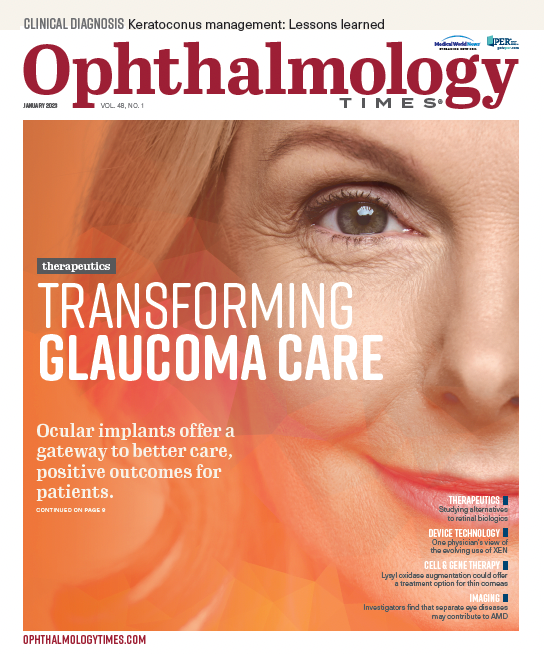Publication
Article
Digital Edition
The retina technology of tomorrow today
Author(s):
Physician discusses existing advancements, innovations for treatment.
Christopher Riemann highlights new applications of existing medications and technology as well as innovative developments in the next 2 years. (Adobe Stock image)

Reviewed by Christopher Riemann, MD
Innovations such as improved visualization for pars plana vitrectomy (PPV) through optical coherence tomography (OCT) in the operating room (OR), the use of methotrexate for proliferative vitreoretinopathy (PVR) prevention, surgery for wet age-related macular degeneration, and gene therapy for inherited retinal diseases will likely be incorporated in retinal ophthalmology in the near future, according to Christopher Riemann, MD. Riemann is a vitreoretinal surgeon at the Cincinnati Eye Institute and a volunteer associate professor at the University of Cincinnati School of Medicine in Ohio.
Speaking at the annual Sally Letson Symposium in Ottawa, Ontario, Canada, Riemann highlighted new applications of existing medications and technology as well as innovative developments in the next 2 years. “What do we do when the anti-VEGF drugs don’t work?” Riemann asked, pointing to examples where a patient had a submacular hemorrhage after receiving monthly anti-VEGF injections. The injection of subretinal tissue plasminogen activator (tPA) provided a solution to this case, which Riemann noted led to a massive improvement seen through OCT.
Methotrexate for PVR prevention
Although the molecular basis of methotrexate’s effectiveness in preventing PVR associated with retinal detachment surgery has not been fully elucidated, ophthalmologists are increasingly using methotrexate for PVR prevention, noted Riemann. “PVR is complicated. It boils down to proliferative secretory and contractile elements. Methotrexate is a natural drug to consider for this purpose, because by competitively inhibiting dihydrofolate reductase, it has both antiproliferative and antisecretory effects in addition to non– dihydrofolate reductase immunomodulatory effects that are specifically antisecretory, including decreasing collagen synthesis,” Riemann explained.
Riemann conducted a pilot study on 29 eyes that presented with either tractional retinal detachment or recurrent PVR and used intra- vitreal infusions of methotrexate for management.1 “We had a 97% single-surgery success rate,” he said, noting methotrexate is attractive as a treatment because it is inexpensive, safe, and reliable.
Although there are no current data from larger prospective studies, Riemann maintained it is reasonable to use intravitreal methotrexate to aggressively control intraocular inflammation in patients undergoing retinal detachment repair. “The use of methotrexate is one way to do that,” Riemann explained.
Using OCT in the OR
There is no debate that OCT is an invaluable technology for screening diseases in ophthalmology, but its use does not have to be limited to the office, according to Riemann. “It’s absolutely indispensable for...preoperative and postoperative assessments for surgical retinal disease,” he said. “And it raises the question that if OCT is indispensable in the clinic, why would it not be useful in the OR?”
Intraoperative OCT allows the depiction of anatomy that is not clinically visible; explains postoperative metamorphopsia, macular folds, and retinal slippage; and provides a logical rationale for face-down positioning in patients undergoing macular reattachment, according to Riemann. He notes it has been employed in clinical trials such as PIONEER (NCT02423161), where it was used in PPV to deliver subretinal tPA.
Riemann conducted a small study 2 decades ago to demonstrate the value of
OCT for diabetic posterior hyaloidal traction (PHT) disease. In that study of 9 eyes, he used OCT to evaluate whether eyes with diabetic macular edema linked to PHT had a maculardetachment. The use of OCT detected 8 of 9 eyes had a shallow macular traction detachment associated with PHT.2
Moreover, Riemann also conducted a small study on intraoperative OCT, showing that eyes with macula-involving retinal detachments managed with vitrectomy surgery and heavy liquids (Perfluoron) always have residual subfoveal subretinal fluid after the air fluid exchange. This finding explains postoperative metamorphopsia and provides a pathophysiological rationale for face-down positioning in patients with macula-involving retinal detachment.3
Intraoperative OCT is regularly used by Riemann to perfect his outcomes in retinal diseases. “No matter how dry you think the retina is or how well you drained, you did not [get it completely dry],” he said. “This small study is important is because it is an example of intraoperative OCT improving our under- standing of the mechanisms of ocular disease in the surgical retinal space.”
Gene therapies for inherited retinal diseases
Gene therapies are beginning to receive approvals to manage inherited retinal conditions, Riemann said. “We are genetically engineering viruses to deliver a healthy copy of a defective gene into retinal cells. The gene therapy that [was] first approved was for the RPE65, a gene we know is essential for the visual cycle.”
The FDA approved the gene therapy voretigene neparvovec-rzyl in 2017 for the management of confirmed biallelic RPE65 mutation–associated retinal dystrophy, a condition that leads to vision loss and may cause complete blindness in certain patients. The gene therapy has been delivered safely via subretinal injection and has produced a dramatic impact on vision post treatment, noted Riemann. The therapy carries a high price tag of $850,000, but Riemann pointed out that most insurance companies cover the cost of this sight-saving therapy. Riemann concluded that the future will see more gene therapies emerge, accompanied by a demand for genetic testing to determine whether patients can benefit from gene therapies.
Christopher Riemann, MD
P: 513-506-9459
This article is based on a presentation by Riemann at the 53rd Sally Letson Symposium from September 8 to 10 in Ottawa, Ontario, Canada. He serves as a consultant and speaker for several companies. He receives money for research from Applied Genetic Tech- nologies Corporation, Alcon, Alimera Sciences, Allergan, Arepio, BioTime/ Lineage Cell Therapeutics, Chengdu Kanghong, Clearside Biomedical, Genentech/Roche, Gyroscope Therapeutics, Janssen/Johnson & Johnson, Lowy Medical Research In- stitute/MacTel, Neurotech, Nightstar Therapeutics/Biogen, Notal Vision, Novartis, Ophthotec/IVERIC bio, Re- generon Pharmaceuticals, REGENX- BIO, and Spark Therapeutics.
References
1. Sadaka A, Sisk RA, Osher JM, Toygar O, Duncan MK, Riemann CD. Intravitreal methotrexate infusion for proliferative vitreoretinopathy. Clin Ophthalmol. 2016;10:1811-1817. doi:10.2147/OPTH.S111893
2. Kaiser PK, Riemann CD, Sears
JE, Lewis H. Macular traction detachment and diabetic macular edema associated with posterior hyaloidal traction. Am J Ophthalmol. 2001;131(1):44-49. doi:10.1016/ s0002-9394(00)00872-2
3. Toygar O, Riemann CD. Intraoper- ative optical coherence tomography in macula involving rhegmatogenous retinal detachment repair with pars plana vitrectomy and perfluoron. Eye (Lond). 2016;30(1):23-30. doi:10.1038/ eye.2015.230

Newsletter
Don’t miss out—get Ophthalmology Times updates on the latest clinical advancements and expert interviews, straight to your inbox.




